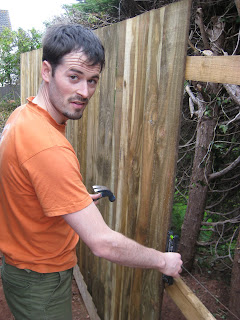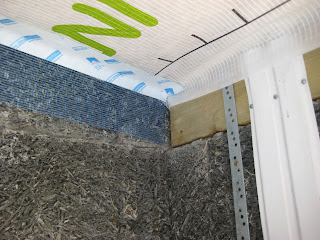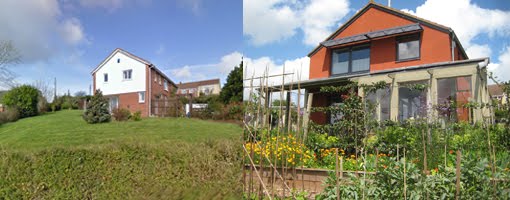We felt we were getting bogged down with some garden jobs, so the boys got the call and responded enthusiastically.
 |
| Rob and Ali set the gravel board |
 |
| Tom builds a custom extension to the fence |
 |
| Chris came by and showed Ali how to install insulation |
 |
| Ben begins his path to master fence builder |
 |
| You can tell the brains from the brawn. Ali, can I have your Autograph? |
 |
| Tom and I install the airtight intelligent vapour barrier - Intello - to the ceiling of the studio. |
 |
| Corner detail of air sealing |
The studio has been a training ground for some of the skills needed for the house refurb. Once you reach a high level of insulation, then most of the heat loss is via infiltration, or unintentional ventilation. The Intello membrane is airtight to prevent precious heat from leaking out, but allows moisture to escape the structure in the summer. In winter it is vapour closed, and keeps the warm moisture in the room from travelling into the insulation layer and condensing. It has to be carefully sealed, though. The blue and white tape has a mesh that will be imbedded between the two layers of plaster, which will create an airtight barrier to the walls. On the right, the membrane will be glued to the timber lintel with a special adhesive, Orcon F. The Durisol is vapour permeable, and will let moisture escape in either direction. The Durisol insulation is plastic foam, and will not absorb moisture.
 |
| Click to enlarge |
Now we get to the geeky bit... the sign of true Passivhaus afficionado is the use of Therm software. Achieving really good levels of wall and roof insulation is easy, but joining them together without a thermal bridge is not , especially in a refurb. Therm gives a contour map of how the temperature flows from inside to outside, and importantly gives the predicted temperatures so you can see if there will be condensation anywhere. Conventionally built houses in Britain with poor ventilation can get mould growing at the junction of the ceiling and wall because of thermal bridging (and too much moisture in the house). More about ventilation soon.
